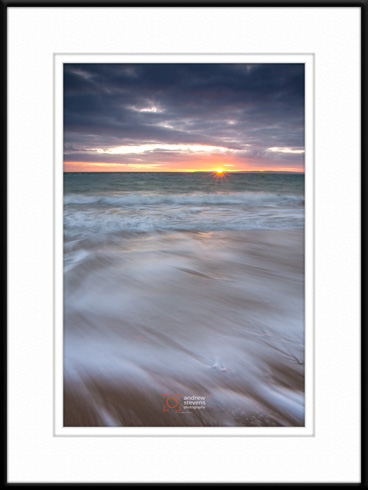in focus
wait for it,
wait for it...

On a recent workshop, I had a (small) Eureka moment!
Henri Cartier-Bresson called it “The Decisive Moment” while Charlie Waite describes being in “the presence of some wonderful alignment of events”.
To me, this particular Eureka moment (a minute or two after the image above was taken) suddenly made perfect sense of these statements and made me realise that some photographers have “it” – whatever “it” might be.
Having led five budding photographers on a very enjoyable coastal workshop, we were spending the last few minutes of daylight capturing some final images. Having spent time through the workshop discussing and shooting lead-in lines and foreground interest, the question came up as to how would I suggest capturing the beach with just the sea and no foreground rocks, groynes or other objects.
With the sun about to set, I was hoping for some reflected colour in the surf at my feet – but the surf looked a little flat. Time for some manipulation – but I’m referring to physical manipulation and not the digital darkroom kind (if you don’t know my normal working style, any more than a minute of post processing is deemed a re-shoot required).
Some chunky pebbles tossed into the sand provided disturbance to the surf as it turned and drew back out to sea. This seemed to work well and added some streaks and definition to the immediate foreground that would help lift the viewer’s gaze up into the image. I was too far away though and this new texture and interest needed to be nearer – time to get wet feet. Heading further into the surf, I pushed the tripod legs firmly into the sand in the hope that my camera wouldn’t try a cross channel swim.
So, I had a brooding sky, some interesting surf and a sun about to set any minute. I wanted to exaggerate the brooding sky and lift the light on the surf a little, so slid the 0.6 (2-stop) Neutral Density Graduated filter out and replaced it with my 0.9 (3-stop).
I virtually always use mirror lock-up combined with the camera's self-timer to minimise the vibrations through the camera body during capture. But when you need precise timing, and have waves lapping around the tripod legs, you can afford to turn the timer off. This allows you to lift the mirror in readiness, than a second press of the cable release to trigger the image capture.
Ok, time to make my image. Having preached the benefits of aperture f/11 all afternoon, it was time to drop to f/22 to a) lengthen the shutter a little to add movement to the water and b) to make use of the diffraction often found at such a small aperture and hopefully capture a starburst around the setting sun.
Focused, composed and poised for action, all I had to do was wait for a wave to come right in past the limits of my viewfinder, let it turn and start to recede, count to two and hit the shutter. And by the way, this sequence had been perfected during the half dozen frames shot before capturing this image! Finally, the “right” wave came in, I watched it all the way in through the viewfinder, felt my ankles get wet, waited for the wave to turn and start to recede, one…two…click. Job done!
Now back to the Eureka moment. Having talked about what I was doing, and captured a pleasing image, it was time for my guests to do the same. Straight away, the difference in our positions was noticed; I was at the water’s edge (if not shin-deep at times) while my guests were a few yards back on dry sand.
Having advanced to the water’s edge and composed the view, it was then time to capture the image. Having talked through the capture process, I noticed the eagerness of my photographers to press the shutter and get a shot – too early, the wave was several feet away from the bottom of the frame and no blur or lead-ins.
Next wave: “wait for it to turn and start to recede before shooting”. Here comes the wave close to the tripod… click. Too early again and static water captured at our feet.
Third wave: “ok, wait for me to say when”.
“Wait…”
“Wait…”
…click.
Too early again. Better, but still no dynamic water.
This is when my Eureka hit me. We can all have top quality cameras and lenses, and lets face it, there aren’t many bad cameras out there these days. We can all learn the capture process and understand aperture settings and their effect on sharpness, light captured and the relation to shutter speed and ISO. I could go on, but the vital element we don’t seem to all be able to grasp, is “it”.
At the start of this post I wasn’t 100% sure what “it” was. Having typed away for a while, I can only think that “it” is timing. My guests captured some pleasing images, and I’m pretty pleased with mine - the only real difference I guess was I waited for the “right” moment before tripping the shutter.
I’m never going to rival Henri’s street photography or Charlie’s landscapes, but that one…two…click is putting me on the right tracks.
Exposure information: 0.6 sec at f/22, ISO100
Filters used: 0.9 Neutral Density Grad filter.
To see a larger version of this image, please click here.
Back to 'in focus' >>